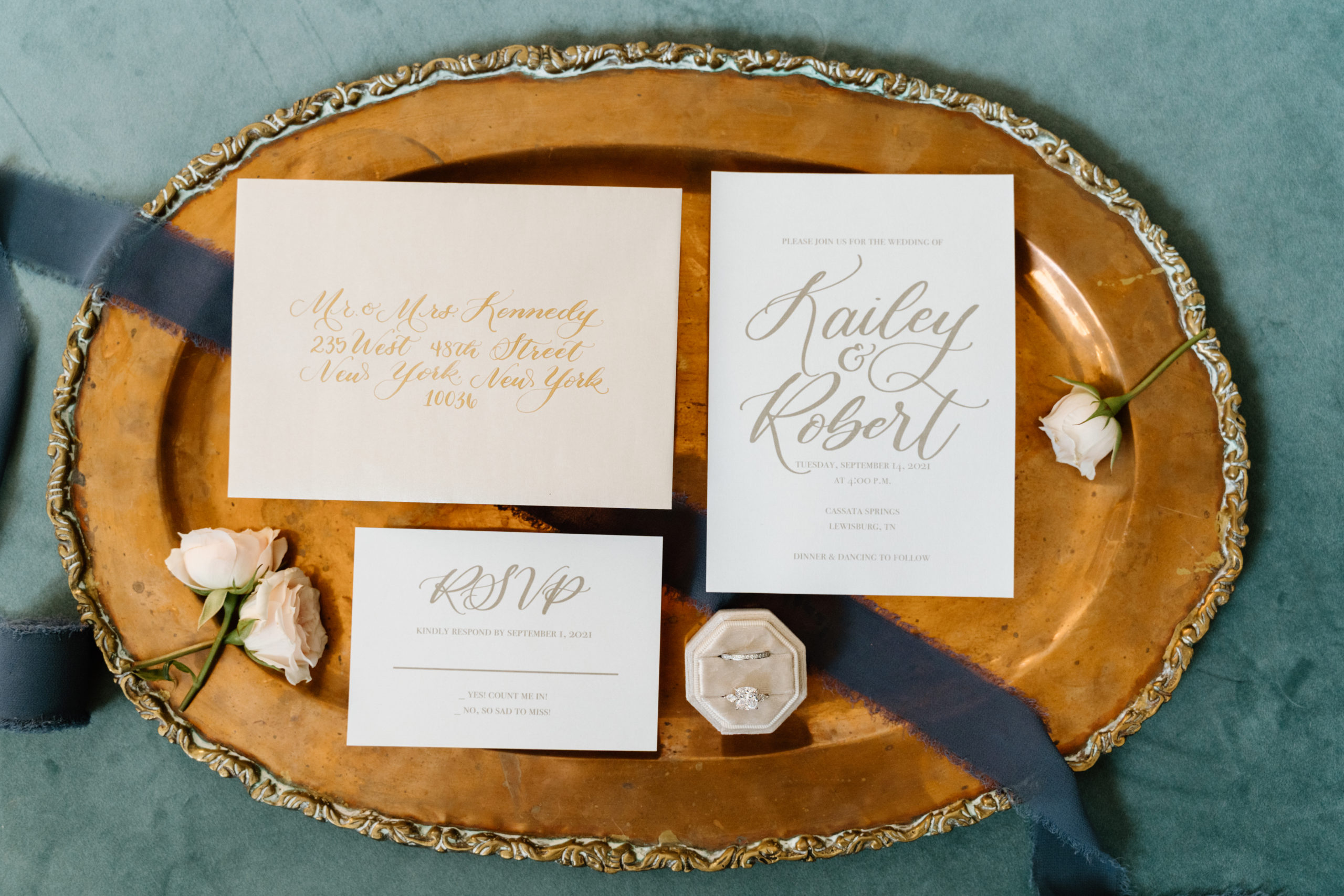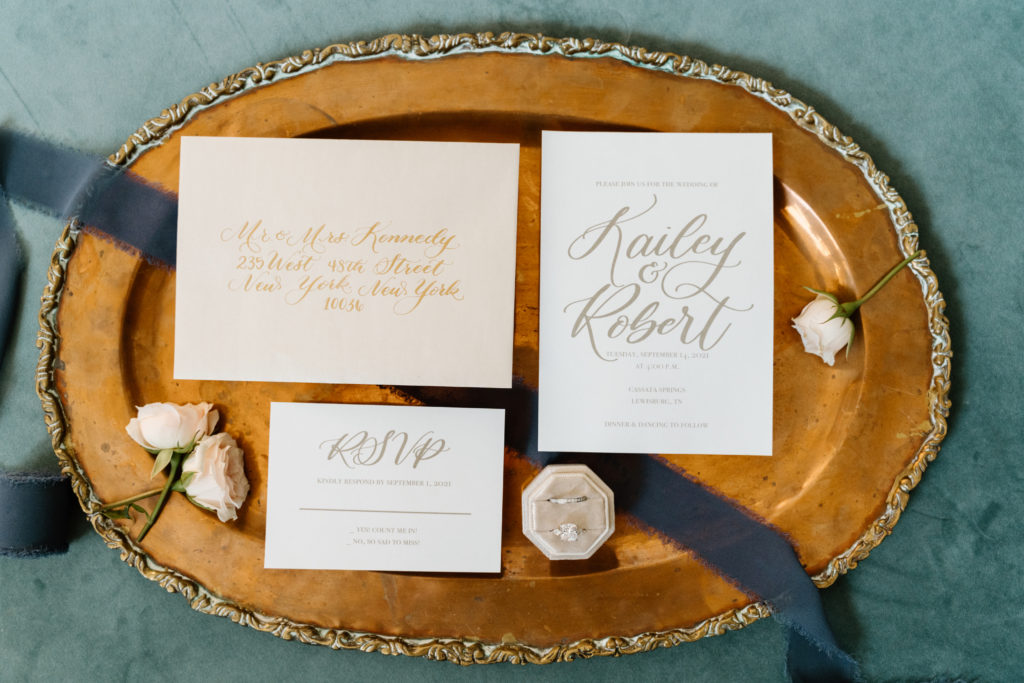What’s inside a wedding invitation?
We’re happy to discuss what a comprehensive wedding invitation entails for anyone unsure or intrigued in today’s blog. Essentially, what you include in your invitation suite is entirely up to you, but some elements should always be there to provide the appropriate wedding information. For the first part, here are the main aspects of wedding invitations: your Main invitation card, Entourage card, RSVP card and envelope, Location map, and Dress card.
The second part is knowing the proper order for creating a wedding invitation: Request lines, Bride and Groom lines, Time and Date lines, Location lines, Reception lines, and RSVP lines. Aside from the first two aspects, another consideration is the wedding theme; the stationery and wording. Finally, properly addressing your guest with your invitation card is essential.
Today’s blog will be a focus on how to address your wedding invitations correctly and in accordance with proper etiquette. In addition, Most websites and etiquette advisers appear to take an all-or-nothing approach when it comes to addressing wedding invitations. Regardless of how you choose to write names on wedding invites, you should respect and appropriately represent your selected guests, taking into account single invitees, same-sex couples, and proper pronoun usage. Here are some fresh and correct ways to address your wedding invitations.
Wedding Invitations to a Married Couple
As traditionally written, “Mr. and Mrs.” for the married couple. But you can also list the names separately if you don’t want to use Mr. and Mrs. Formally written their names in the same line. If the couple has different names, you can start with the person that closest to you. And if both are close to you, you can either use alphabetical order for their names listed.
- “Mr. & Mrs. Geoff Wang”
- “Mr. Geoff Wang & Mrs. Joy Wang”
- “Geoff Wang & Joy Wang”
- “Geoff & Joy”
When addressing a spouse who has preferred to hyphenate their last name, use the following format:
- “Mr. Smith and Mrs. Cruz-Smith”
Wedding Invitations to an Unmarried Couple
Unmarried couples who live at the same address receive invitations addressed to both on the same line. Another way to address the unmarried couple is to write down first with who you are closest to and write on a separate line. There should be no “And” for this format. Also, the unmarried couple should be addressed with their titles and last names.
- “Mr. Richard and Ms. Grace”
- “John and Nicole”
Wedding Invitations to a Single Female and Male
Traditionally and even in modern time, if the female guest is over the age of 18, use “Ms.” If she is younger, “Miss” is appropriate; it should be written out rather than abbreviated as an initial.
For your male guest, if he is over 18, use “Mr.” Otherwise, there is no need for a title.
- “Ms. Alice Branch”
- “Miss Anna Lee”
- “Mr. Mark Gil”
Wedding Invitations To a Family
Decide whether you want to be specific about who is invited before sending wedding invites to a family. If you don’t want to single out anyone in the family, simply address the envelope to the entire family.
- “The Bostons’ Family”
If you have a change of mind and want to be specific about which family members to invite, make a list of everyone’s names. First should be the names of the parents, and then the name of the invited children in order of age. Use the appropriate address for single female children. If “Ms” or “Miss.”
- The Boston Family Mr. and Mrs. Homer Simpson
Mr. Alex Boston
Miss Anna Boston
Wedding Invitations to a Couple with Significant Titles
If the couple are both doctors, lawyers, or military personnel, proper addressing for their invitation is crucial. You may indent the second line if both titles don’t fit on one line. If one of the couple use hyphenates, the same format applies.
- “Doctor Greg Louis and Doctor Anna Park-Louis”
- “The Doctors Louis”
- “Judge Lance Florence and Judge Mikee Florence”
If the couple has different titles, apply the same rules. Indent the second line if both titles don’t fit on one line. Also, regardless of gender, whichever side of the pair “outranks” the other goes first.
- “The Honorable Alice Smitten and Mr. John Smitten”
- “Captains Michelle and Fred Will, US Navy”
Wedding Invitations to a Same-Sex Couple
Same-sex couples must follow the same manners as any other married or single pair. List both names on the same line if they’re married or live together. If one of the partners has a hyphenated last name, list it last. On the other hand, you can list names alphabetically or according to which visitor you’re closest with, a couple with distinct last names.
- “Ms. Lea Nicoles” and “Ms. Margie Nicoles”
- “Ms. Dianne Samonte” and Ms. Jen Parr-Samonte”
- “Ms. Venus Ayala” and “Ms. Mariz Lance”
Addressing Wedding Invitations in General
It is essential to keep in mind the basics of addressing your wedding invitation. Generally, indent the second line if both guests’ names don’t fit on one line. You might be able to get away with addressing your envelopes less formally if you’re planning an informal wedding. Otherwise, it is always ideal on the side of formality. However, even if your wedding is on the casual side, there are a few regulations to follow:
- Make use of formal names, no nicknames.
- Middle names are optional but must be spell clearly and use, also no initials.
- All nouns like Apartment, Avenue, Street, and so on must spell out.
- Mr., Mrs., Ms., and Jr. can all be abbreviated.
- Write professional titles like “Doctor” or “Professor.”
Why Should You Address Wedding Invitations Correctly?
Addressing your wedding invitations properly (also, name and title spell, keep in mind) is not just in favor of etiquette’s sake but also for logistical reasons. The manner you address your wedding invites is critical. First and foremost, you’re sending a message about the guest who you are officially inviting to your wedding. Second, suppose you manage to address your wedding invites incorrectly. . It is also important to note that etiquette is essentially about treating others with respect; the first and most important guideline is to address people in the manner they prefer to be addressed. This rule takes precedence over all others.
Finally, while it’s crucial always to try to get things right, you’ll likely make a mistake or two in how you address someone. Even the most formal people have realized that the world is less formal than before. Couples should be close enough to their wedding guests to be aware of their preferences. They should also be quick to forgive a mistake made in good faith. On top of it all, the couple should enjoy this part of their wedding, the invitation.
Invitation Flat Lay from a Styled Shoot: Elms Lettering
Ready to book your wedding day with Diana Marie Photography?


+ Comments